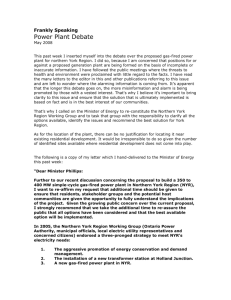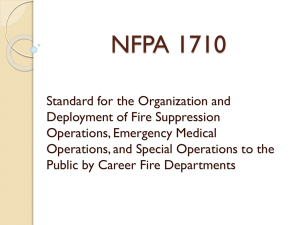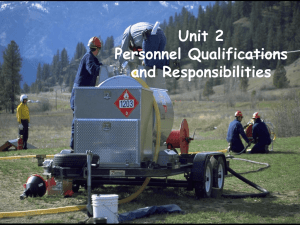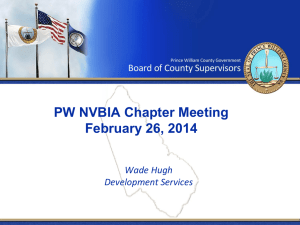Chapter 7
advertisement
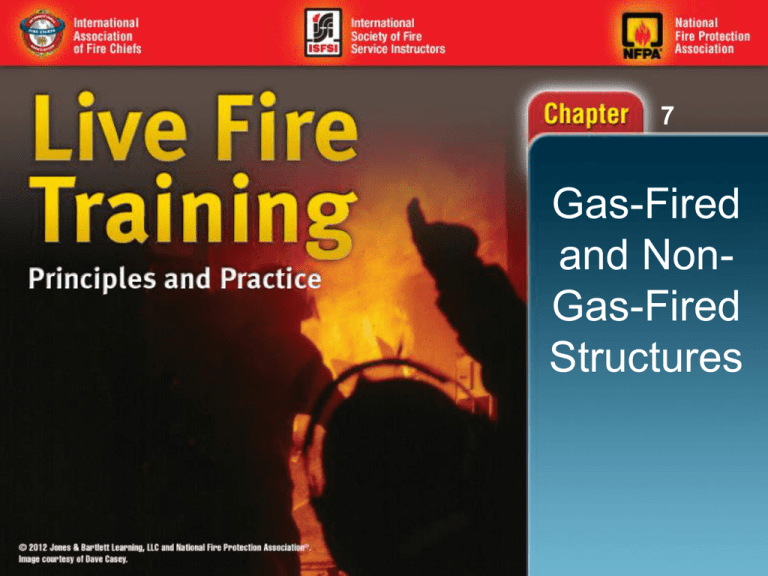
7 Gas-Fired and NonGas-Fired Structures 7 Knowledge Objectives (1 of 5) • Identify the codes, standards, and guidelines to consult when building a permanent live fire training structure. • Discuss how procedures and due diligence are critical in ensuring safety in a permanent live fire training structure. • Describe the characteristics of a gas-fired live fire training structure. 7 Knowledge Objectives (2 of 5) • Discuss the policies that must be followed when working in a gas-fired live fire training structure. • Describe the characteristics of a non-gas-fired live fire training structure. • Discuss the policies that must be followed when working in a non-gas-fired live fire training structure. 7 Knowledge Objectives (3 of 5) • Identify the general features in permanent live fire training structures that assist in providing realistic training evolutions. • Identify the information that must be included in the preburn plan. • Describe how to create the emergency plan and ensure that it is implemented correctly. 7 Knowledge Objectives (4 of 5) • Describe how to ensure the safety of spectators, media, and visitors. • Describe how to ensure the water supply is adequate for training evolutions. • Describe how to ensure on-site facilities. • Describe how to maintain permanent live fire training structures. 7 Knowledge Objectives (5 of 5) • Describe how to prepare a gas-fired live fire training structure for a safe training evolution. • Describe how to prepare a non-gas-fired live fire training structure for a safe training evolution. • Describe how to ensure a safe ignition and burn with a gas-fired system. • Describe how to ensure a safe ignition with a non-gas-fired system. 7 Skills Objectives • Inspect and prepare a gas-fired live fire training structure. • Inspect and prepare a non-gas-fired live fire training structure. 7 Introduction • Two basic types of permanent live fire training burn buildings – Gas-fired – Non-gas-fired • NFPA 1403, Standard on Live Fire Training Evolutions, covers the specific requirements for both types of structures. 7 Code Requirements • NFPA 1402, Guide to Building Fire Service Training Centers, is the guideline to use when building a new facility. • A standard is not law unless adopted by the authority having jurisdiction (AHJ) or governmental authority. 7 Making and Enforcing the Rules • Facility manager – Ensures that concise procedures are in place • Procedures include normal to emergency activities. • Some facilities post the rules. Courtesy of the Loudon County Department of Fire, Rescue, & Emergency Management 7 Types of Live Fire Training Structures (1 of 11) • Permanent live fire training structures: designed to withstand repeated fires without incurring damage – Gas-fired live fire training structures: permanent structures where burn sets are fueled by liquefied petroleum gas (LPG) or propane – Non-gas-fired live fire training structures: permanent structures where fires are fueled by Class A materials 7 Types of Live Fire Training Structures (2 of 11) • Structures made of steel, concrete, masonry construction • Can be freestanding, part of a training tower, or mobile structure • Built with extremely heatresistive material, allowing for repetitive fires and extended use 7 Types of Live Fire Training Structures (3 of 11) • Thermal shock: ceiling, walls, floor surfaces heat unevenly and expand; then rapidly, unevenly are cooled by hose streams. • Newer facilities have insulation panels and replaceable, nonload-bearing walls. 7 Types of Live Fire Training Structures (4 of 11) • Gas-fired live fire training structures —Fueled with LPG or propane gas —Computer-controlled systems evaluate conditions and shut down if unsafe. Courtesy of Kidde Fire Trainers, Inc. 7 Types of Live Fire Training Structures (5 of 11) • Gas-fired live fire training structures (cont.) —Able to simulate specific scenarios —Dead man switch can shut fire down and initiate ventilation. Courtesy of Kidde Fire Trainers, Inc. 7 Types of Live Fire Training Structures (6 of 11) • Gas-fired live fire training policies —Fuel and fire locations —Heat ranges —Types of scenarios —Simultaneous training evolutions —Staffing requirements —Host personnel 7 Types of Live Fire Training Structures (7 of 11) • Non-gas-fired live fire training structures —Produce higher temperatures than gas-fired structures —Less expensive to build than gas-fired —Lack safety controls found in gas-fired —Many instructors find them more realistic. 7 Types of Live Fire Training Structures (8 of 11) • Non-gas-fired live fire training policies – Fuels selected per NFPA 1403 and AHJ – Follow specific fuel load amount and staging policies. – Set maximum temperature levels. 7 Types of Live Fire Training Structures (9 of 11) • Non-gas-fired live fire training policies (cont.) – Locations and types of training evolutions – Concurrent training evolutions allowed by NFPA 1403 – Staffing requirements follow NFPA 1403. 7 Types of Live Fire Training Structures (10 of 11) • Temperature monitoring – Relying too much on temperature reading is dangerous. – Many factors influence danger levels. – Carefully monitor conditions. 7 Types of Live Fire Training Structures (11 of 11) • Shipping containers – Used with Class A fuels or gasfired systems – Thermal liners protect container from thermal shock. – Need to comply with NFPA 1403 7 Features of Live Fire Training Structures • Some features include: – Car props – Enclosed interior stairs – Sound systems – Realistic layouts – Doors and windows – Attic areas – Ducted smoke distribution – Roof vent props 7 Preburn Plan (1 of 6) • The preburn plan needs to include: – Specific objectives – Who will participate – Water supply – Apparatus – Rapid intervention crews/emergency procedures – Incident management staffing/team organization 7 Preburn Plan (2 of 6) • The preburn plan needs to include (cont.): – Order of operations – List of the training evolutions – Assignments and rotation – Communications plan – Building plan – Site plan – Emergency medical plan – Areas for staging, operating, parking 7 Preburn Plan (3 of 6) • The preburn plan needs to include (cont.): – Policy for use of personal protective equipment (PPE) and self-contained breathing apparatus (SCBA) – Checklist to confirm with agencies notified that evolutions are to be conducted – Requirements for other agencies – Acceptable weather parameters – Demobilization plan – Policy/plan for spectators, media, visitors 7 Preburn Plan (4 of 6) • Participants must walk through structure. • Emergency plan requires rapid intervention crews to be in place. • Building evacuation plan must be known by all. • Spectators to be kept away from operations 7 Preburn Plan (5 of 6) • Instructor-in-charge determines water flow needs. • On-site facilities, such as restrooms and lights, are essential. Courtesy of Robert Hernandez, Miami-Dade Fire Rescue 7 Preburn Plan (6 of 6) • Instructor-in-charge and safety officer check inspection records. • NFPA 1403 requires engineer with live fire training structure experience and expertise. • Structures are evaluated for safety. • If structural damage is severe enough to affect safety of participants, live fire training is not permitted. 7 Preparation (1 of 8) • • • • Check proximity to other structures. Identify adjacent properties. Identify and designate parking areas. Identify fire-ground location for press and spectators. 7 Preparation (2 of 8) • Preparation and inspection – Look for signs of lack of structural integrity. – Check doors and windows for easy operation. – Search structure for unauthorized persons, animals, objects. – Check stairs and railings. – Check roof vent. – Look for any debris. – Damage should be documented. 7 Preparation (3 of 8) • Preparation and inspection (cont.) – If damage is significant, training not permitted – All devices checked and operated prior to evolution – Awareness of weather conditions – Sources of ignition or unidentified materials removed – Check burn set locations or gas-fired systems. 7 Preparation (4 of 8) • Instructors run gas-fired props and systems with students to ensure correct operation. • Instructors must: – Be familiar with fire room environment – Not place anything on gas-fired props – Watch for debris 7 Preparation (5 of 8) • Inspection of non-gas-fired live fire training structures includes: – Visual inspection of the structure – Adjacent properties identified and informed of date and time of training evolution – Streets or highways surveyed – Instructor-in-charge documents fuel loading. – Identify exact burn locations. 7 Preparation (6 of 8) • Inspection of non-gas-fired live fire training structures includes (cont.): – Excessive fuel load contributes to conditions of dangerous fire behavior. – Ensure primary and secondary exit paths do not conflict with expected fire spread. – Burn set placed in a corner of room – Burn set cannot be located in exit path. 7 Preparation (7 of 8) • Inspection of non-gas-fired live fire training structures includes (cont.): – No burn room used that does not have two separate means of egress – Hearths, fireboxes, steel drawer, large pan can be used. 7 Preparation (8 of 8) • Inspection of non-gas-fired live fire training structures includes (cont.): – Use Class A materials only. – NFPA 1403 allows concurrent, multiple fires in permanent non-gas-fired live fire training structures. 7 Operations (1 of 3) • Operations in permanent live fire training structures require less personnel; less laborintensive than acquired structures. – Still need to follow considerations and perform a walk-through • Instructors must be qualified by the AHJ. • Ignition decisions made by instructor-in-charge and safety officer. – Follow Go/No Go sequence. 7 Operations (2 of 3) • Gas-fired systems have automatic ignition systems. – Instructor must visually confirm burn area is clear of personnel. – Communication is critical. 7 Operations (3 of 3) • Non-gas-fired systems – Setup of burn rooms and ignition process follow same procedures as acquired structures. – Nobody can operate inside the structure alone. 7 Overhaul • Once evolutions complete: – Check for injuries. – Check for damage to PPE and SCBA. – Report any damage, deficiencies, and repairs needed. – Leave facility in a safe condition. 7 Summary (1 of 2) • Use of permanent live fire training structures reduces chance of problems that occur in acquired structures. • They are designed to withstand repeated fires without incurring damage. • Gas-fired structures are fueled with liquefied petroleum gas or propane. • Non-gas-fired structures produce higher temperatures than gas-fired structures. 7 Summary (2 of 2) • Develop preburn plan. • Fire structure must be properly maintained and structural integrity inspected once a year. • Fire structure is inspected for hazards and prepared before training evolutions. • Safety is crucial.

